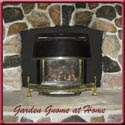I wrote about our first encounters with creepy crawlies shortly after moving into this house. Every house brings its problems as far as pests go. The house I grew up in backed onto a river and had a dirt floor basement. Oh how I hated that basement. Mice were normal inhabitants and it seemed there was nothing my Mom could do to rid the house of them. But we also had other lovelies like muskrat, snapping turtles, skunks and snakes not only on the property but they would find a way into that basement. Our first apartment as a married couple was brand new and blissfully pest free except for the occasional fly or mosquito. After several apartments all for the most part relatively pest free we bought our first house that aside from the occasional spider, flies and mosquitoes was also pest free. Our second house was on a crawspace so while insects weren't a huge problem in the house itself they were likely in the crawlspace. The third house introduced us to the joys of earwigs! The fourth house took away the earwings and gave us mice, a bumble bee hive as well as a snake nest in the crawlspace. This house continues with rodent concerns (voles, field mice), a return of earwigs, sow bugs, spiders, black ants, centipedes and millipedes, skunks, raccoons, possums and rabbits.
 Dead Centipede!
Dead Centipede!
April 9, 2008
Most concerning are the centipedes because they are horrid looking despite being harmless to humans. If they bite which is highly unlikely it is no worse than a bee sting. My philosophy for insect control rests with elimination followed by prevention. In order to do this you really need to know your pest. Unfortunately, the centipedes have continued to invade or more likely we are seeing the babies that have not been able to get out of the house. The problem is the centipedes appear when least expected usually when I'm holding a full cup of coffee! So I decided to do a bit of research to see exactly what I was up against.
The House Centipede (
Scutigera coleoptrata) lives its entire life cycle in buildings usually on the ground level where it preys on other insects like spiders, cockroaches, termites, silverfish, ants and bedbugs. It reaches a length of 1 to 2 inches and has 15 pairs of legs that allow it to run at lightening fast speeds across floors and ceilings as well as climb walls. These menacing looking critters can live up to five years in a house. They lay their eggs in the spring. Newly hatched centipedes have 4 pairs of legs, gaining new pairs of legs with the first molt and two pairs with each successive molt. House centipedes are predators and therefore when you see them in the house they are a good indicator of other insects being present whether or not you can see them. So House centipedes are actually beneficial inside the house.
Elimination: The first rule of thumb when trying to control centipedes is to remove any clutter or hiding spots then look for signs their prey. Remove their prey and habitat, the house centipedes will move on. Aside from spiders that tend to construct webs where there is a draft, other insects may not give a clue as to how they are getting in so start with spiders. Every time you see a spider web mark that spot, remove the web and caulk. Use a pesticide with a residual effect (eg. Hot Shot® Ant Killer Plus or Spider Killer, kills up to 3 months) along cracks, crevices and baseboard. Make sure you treat all rooms and behind all furniture as this will assist you in investigative measures at the next step. A surprising number of insects can get in the house via the tiny cracks around removable window screens. Use a residual spray both inside and out on all window and door frames. Don't forget to keep doors especially patio door screens closed to prevent insects from getting in the house. Spray all outside entry points with a residual spray (eg. Raid Outdoor Ant & Roach, 4 week residual effect) such as but not limited to any wires or pipes that go through the house wall as well as where the house sits on the sill. This will effectively kill off those insects such as termites or ants that may be using wires and plumbing as a port of entry. Leave as is for 4 to 5 days then caulk well for a permanent solution.
Investigative measures: After spraying indoors with a residual spray you will need to take investigative measures. This means checking the perimeter of every room in your house at least daily for the next week. Use a post-it note to mark any location where you find dead insects. Clean up any dead insects to remove the food source for those insects that feed off of decomposing insects. Continue checking any areas where you find dead insects while also checking for new locations.
Insects are seldom found hovering near their port of entry. Centipedes will commonly be found near drains in the kitchen or bathrooms because they need moisture not because that is where their food supply is or that's how they got in. Spiders will be found near cracks because the draft helps cool their egg sack. Carpenter ants will be found in wood that has had moisture problems. The problem is if you see one insect you can be sure his bothers, sisters and all other relatives are happily living in your home as well. You should only need to use a residual spray once in the house with the exception of window and door frames that are being opened provided you continued prevention. The residual spray accomplishes three things. First it kills off those insects present in the house and continues killing them off for a period of time. Second, the residual effect will often kill invading insects quite close to where they are entering the house so that is the area you should focus on first for sealing. Third, a residual spray will give you a time frame within which time you should be able to seal all entry points. That means if you discover a problem in the winter when getting outdoors to seal with caulk would be difficult a residual spray will buy you enough time for the weather to start warming so you can seal.
Prevention: No house or building will ever be 100% insect free but with preventative measures they should be relative pest free. Ok, so you have done your initial elimination and investigation so now it is onto prevention.
- habitats: Any moisture problems such as dripping taps inside or outside, standing water, damp laundry on floors and similar should be fixed. Hang any damp clothes on a rack off the floor if they cannot be washed immediately. Inside keep rooms clutter free and clean! Clutter provides a wonderful pest habitat allowing them to reproduce without you even knowing they are there except for an occasional sighting. Remove centipede habitats such as decaying mulch, English ivy, and decaying clippings to create a 5 foot barrier around your home. Correct any moisture problems such as faulty drainpipes or standing water near the house foundation.
- food source: Centipedes will not go after your food supply but they do prey on other insects that will enjoy a free food handout. All dried foods (sugars, flours, pastas, cereals and etc) should be stored in glass, metal or plastic containers. Be warned that some of these foods can introduce insects to your home so I go as far as to isolate new purchases right away to prevent any introduce insect invasion from spreading. Also be warned that a determined rodent can chew through plastic so if rodents are a problem use glass or metal containers. Keep your counters and floors squeaky clean. If you have windows at ground level as our main living area has, keep all food in the fridge and off the counters or keep the windows shut if you have problems with rodents, skunks and etc. Vacuuming regularly will remove any eggs insects have deposited as well as dead insect carcasses other insects feed on or catch the occasional insect that got through your defenses. Again, keep your home clutter free! Silverfish are prey for centipedes and earwigs. They feed off of glues in book bindings and magazines as well as photos, sugar, hair and dandruff. So if you have a large population of silverfish in your home hiding in those stacks of paper clutter in your basement, you will likely have a healthy population of house centipedes and/or earwigs. Store these types of food sources in sealed cabinets or plastic bins. Eliminate the silverfish and you eliminate the centipedes.
- keep them out: Caulk any entry points regardless of how small they appear. Careful caulking using a high quality (20 year plus) caulk will help keep pests out. Use weather stripping on screens to prevent spiders and other creepy crawlies from getting underneath. Continually check for any cracks especially in the spring and fall months. Seal any cracks that you find immediately. Keep a constant look-out for any signs of re-infestation so you can nib those in the bud before they become a problem.
Using these methods we have almost entirely rid our house of centipedes. They no longer see our house as a friendly place to hunker down because both their prey and habitat have been eliminated. We are still checking for cracks and other points of entry on a regular basis. We still see the occasional centipede but that's to be expected until the house is fully sealed and given the fact that we have likely sealed a few centipedes from getting out.
Garden Gnome
©2006-2008
 Materials
Materials Cutting
Cutting Taped
Taped Finished
Finished



 Coffee to Go
Coffee to Go Bottled Water
Bottled Water Family Room
Family Room View 1
View 1 View 2
View 2 Grout Sealing
Grout Sealing Caulking
Caulking Shelf Edging
Shelf Edging Window Trim
Window Trim












